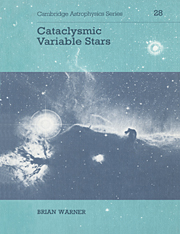5 - Novae in Eruption
Published online by Cambridge University Press: 23 December 2009
Summary
All that's bright must fade, – The brightest still the fleetest.
Thomas Moore. All That's Bright Must Fade.The topic of nova explosions introduces areas of physics not touched upon in previous chapters: white dwarf structure, nuclear reactions, hydrodynamics of explosive mass loss, common envelope structures, non-LTE conditions in low density ejecta, dust formation. At the same time these are areas that have been comprehensively reviewed and referenced in recent books and articles. This chapter therefore concentrates on the basics of eruption physics, expanding only in those parts that relate strongly to the properties and evolution of the classes of CVs discussed in other chapters. Novae between eruptions are discussed in Chapter 4.
Two books provide detailed reviews of observation and theory of nova eruptions: The Galactic Novae (Payne-Gaposchkin 1957) and Classical Novae (Bode & Evans 1989). The latter contains a comprehensive list of references to observational papers on novae published to the beginning of 1987. Modern review articles, and a few early ones still of value, are Stratton (1928), McLaughlin (1960a), Gallagher & Starrfield (1978), Truran (1982), Bode & Evans (1983), Starrfield (1986, 1988, 1990, 1992), Starrfield & Snijders (1987), Gehrz (1988), Shara (1989), Seitter (1990). Specialized conference proceedings appear in Friedjung (1977) and Cassatella & Viotti (1990).
Lists of novae, finding charts and references are given in Duerbeck (1987), Bode & Evans (1989) and Downes & Shara (1993).
Nova Discovery
Prior to the introduction of wide-field sky photography in the late nineteenth century novae were found generally as naked eye objects.
- Type
- Chapter
- Information
- Cataclysmic Variable Stars , pp. 257 - 306Publisher: Cambridge University PressPrint publication year: 1995
- 2
- Cited by

